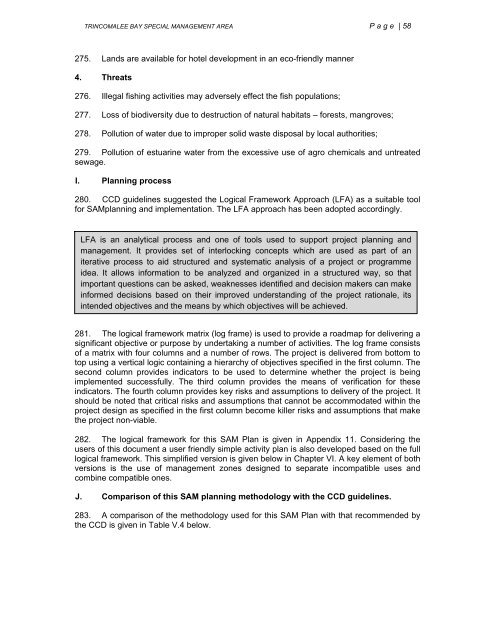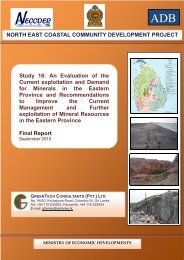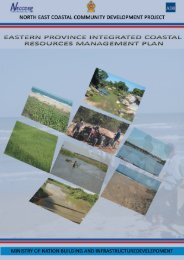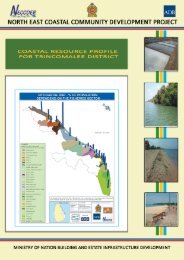Untitled - Neccdep.com
Untitled - Neccdep.com
Untitled - Neccdep.com
You also want an ePaper? Increase the reach of your titles
YUMPU automatically turns print PDFs into web optimized ePapers that Google loves.
TRINCOMALEE BAY SPECIAL MANAGEMENT AREA Page | 58<br />
275. Lands are available for hotel development in an eco-friendly manner<br />
4. Threats<br />
276. Illegal fishing activities may adversely effect the fish populations;<br />
277. Loss of biodiversity due to destruction of natural habitats – forests, mangroves;<br />
278. Pollution of water due to improper solid waste disposal by local authorities;<br />
279. Pollution of estuarine water from the excessive use of agro chemicals and untreated<br />
sewage.<br />
I. Planning process<br />
280. CCD guidelines suggested the Logical Framework Approach (LFA) as a suitable tool<br />
for SAMplanning and implementation. The LFA approach has been adopted accordingly.<br />
LFA is an analytical process and one of tools used to support project planning and<br />
management. It provides set of interlocking concepts which are used as part of an<br />
iterative process to aid structured and systematic analysis of a project or programme<br />
idea. It allows information to be analyzed and organized in a structured way, so that<br />
important questions can be asked, weaknesses identified and decision makers can make<br />
informed decisions based on their improved understanding of the project rationale, its<br />
intended objectives and the means by which objectives will be achieved.<br />
281. The logical framework matrix (log frame) is used to provide a roadmap for delivering a<br />
significant objective or purpose by undertaking a number of activities. The log frame consists<br />
of a matrix with four columns and a number of rows. The project is delivered from bottom to<br />
top using a vertical logic containing a hierarchy of objectives specified in the first column. The<br />
second column provides indicators to be used to determine whether the project is being<br />
implemented successfully. The third column provides the means of verification for these<br />
indicators. The fourth column provides key risks and assumptions to delivery of the project. It<br />
should be noted that critical risks and assumptions that cannot be ac<strong>com</strong>modated within the<br />
project design as specified in the first column be<strong>com</strong>e killer risks and assumptions that make<br />
the project non-viable.<br />
282. The logical framework for this SAM Plan is given in Appendix 11. Considering the<br />
users of this document a user friendly simple activity plan is also developed based on the full<br />
logical framework. This simplified version is given below in Chapter VI. A key element of both<br />
versions is the use of management zones designed to separate in<strong>com</strong>patible uses and<br />
<strong>com</strong>bine <strong>com</strong>patible ones.<br />
J. Comparison of this SAM planning methodology with the CCD guidelines.<br />
283. A <strong>com</strong>parison of the methodology used for this SAM Plan with that re<strong>com</strong>mended by<br />
the CCD is given in Table V.4 below.














